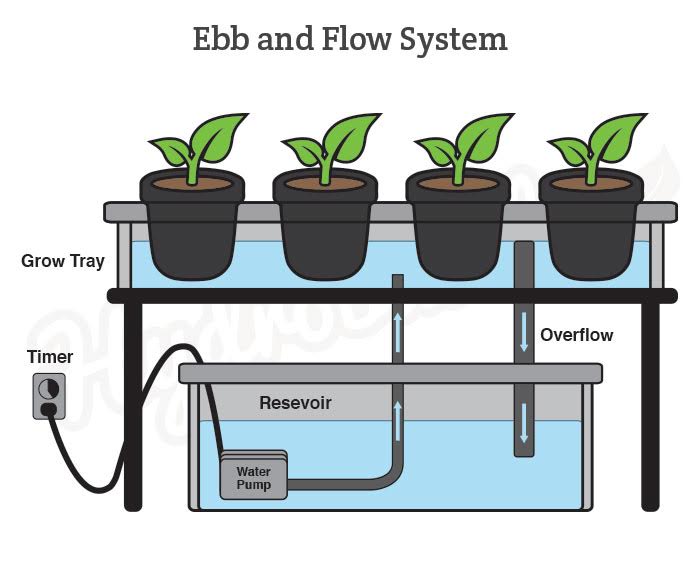What is an ebb and flow system?
Ebb and flow hydroponic systems are some of the more popular ways to grow indoors. Ebb and flow is sometimes referred to as flood and drain, ebb flow, and flow or flood. These systems are great for those new to hydroponics because of their simple operation.
This isn't to say growing in a flood & drain system is easy. There is still a rather steep learning curve.
Once you get used to the concept, these systems can help cultivate some incredibly amazing plants!

A grow tray (flood table) holds the plants in place, and is supported by a stand or rolling bench. The hydroponic reservoir is housed underneath, holding hydroponic nutrients and water. Using a rolling bench will allow you to maximize space in the grow room or greenhouse. Rolling benches allow you to get rid of unneeded aisles.
Growers have multiple options of what type of grow medium they can use when growing with this method. Growers will often use net pots or fabric pots filled with hydroponic grow media such as clay pebbles. Using net pots allows for easier movement of plants.
Using a grow media helps secure plants' roots making the plant grow stronger and more sturdy during the plant growth phase.
What does the phrase 'ebbs and flows' mean?
Just as the name sounds, an ebb & flow system will flood the root zone with nutrients and water. After about 10-15 minutes it will slowly drain back into the reservoir. The phrase comes from the ocean’s high and low tide. The sea level ebbs and flows every day.
How does an ebb and flow system work?
In this style of growing, a water pump is responsible for moving nutrients up to the flood table. A timer or controller is used that sets the flood and drain cycles which occur 4-6 times a day. During the flood phase the root zone will soak up the nutrient solution for 10-15 minutes at a time. It will then drain back down to be used again.
Ebb and Flow Aeration
While the water and nutrients soak the root zone during the flood cycle, the plants are not exposed to oxygen. For this reason, it is very important to ensure adequate oxygen in the hydroponic growing media and plant root zone.
Using an air pump and air diffuser in the reservoir will introduce more oxygen into the nutrient solution. This helps maximize growth, nutrient uptake, and overall plant health.
Why do some hydroponic systems require air pumps?
Growing plants in water still require oxygen. Some hydroponic growing systems such as aeroponics don't need to use air pumps to get air to the root zone.
When using aeroponics, a water pump is used to spray a mist of water and nutrients directly at the plant's roots. Oxygen is added to the plant's roots as the nutrient solution is sprayed to the root zone from the mister.
Choosing the best hydroponic ebb and flow system
There are a few factors when deciding which flood and drain systems are best for you. You should first consider the number of plants you want to grow. Then consider the space you have to grow in as well as your budget. The type of plants you want to grow will affect which system is best for you.
Hobby growers looking to grow a few plants in smaller growing areas should consider hydroponic systems that house 4-8 plants. If you’re a commercial growers you’ll be looking to get the most out of your space. Often large grow tray systems are the answer.
You will also need to consider how big you want your plants to get. If you are growing a smaller plant or are tight on space, a 2 gallon growth module will be perfect. For those looking to grow huge, heavy plants, a 5-6 gallon bucket will deliver better results.
What are the different types of hydroponics?
Deep Water Culture (DWC) - The plant’s roots are suspended in an oxygen-rich nutrient solution.
Aeroponics - Plants are suspended in the air and misted with nutrient-rich water.
Drip Hydroponics - Water and nutrients are pumped from the tank below and dripped over the plant root zone.
If you are unsure which system is best for you, give our master growers a call and we will help! Reach us at 888-815-9763 or email sales@hydrobuilder.com.
For more information on hydroponic systems, check out our learning center! We also have an article talking about the differences between aeroponics and hydroponics. For a better understanding of each of the types of hydroponics systems, read our full guide.
